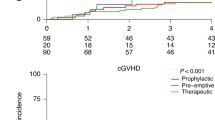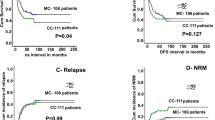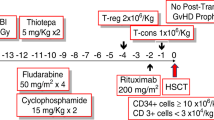Abstract
The aim of this study was to analyse the experience of Polish Pediatric Group for Hematopoietic Stem Cell Transplantation in respect to donor lymphocyte infusion procedure. The study included 51 pediatric patients with malignant (45) and non-malignant (6) diseases treated with DLI in the period 1993–2012. The indications for DLI were as follows: (1) increasing recipient chimerism after non-ablative hematopoietic SCT (18 patients); (2) immunomodulation after a reduced intensity conditioning regimen (2 patients); (3) increase in minimal residual disease detection (3 patients); and (4) relapse (28 patients). DLI was carried out at a median of 6 (0.5–79) months after SCT. DLI was administered as either a single-dose (in 19 cases) or in escalating-dose regimens (in 32 cases). The median total dose of CD3-positive T cells was 28.0 (0.1–730.0) × 106/kg body weight. The time for assessment of DLI efficacy ranged from 0 to 70 (median 3) months. At evaluation, 18 patients experienced CR, 3 achieved PR, 19 showed relapse and 11 rejected the graft. DLI was found to be effective in 39% of cases. Complications of the procedure occurred in 18 patients; of these, 2 died. To sum up DLI shows efficacy in a significant percentage of children. Mortality related to the therapy adverse effects is low. However, this method requires standardization.
This is a preview of subscription content, access via your institution
Access options
Subscribe to this journal
Receive 12 print issues and online access
$259.00 per year
only $21.58 per issue
Buy this article
- Purchase on Springer Link
- Instant access to full article PDF
Prices may be subject to local taxes which are calculated during checkout

Similar content being viewed by others
References
Slavin S, Naparstek E, Nagler A, Ackerstein A, Kapelushnik J, Or R Allogeneic cell therapy for relapsed leukemia after bone marrow transplantation with donor peripheral blood lymphocytes. Exp Hematol 1995; 23: 1553–1562.
Deol A, Lum LG Role of donor lymphocyte infusions in relapsed hematological malignancies after stem cell transplantation. Cancer Treat Rev 2010; 36: 528–538.
Introna M, Barbui AM, Golay J, Rambaldi A Innovative cell-based therapies in onco-hematology: what are the clinical facts? Haematologica 2004; 89: 1253–1260.
Porter DL, Antin JH Donor leukocyte infusions in myeloid malignancies: new strategies. Best Practice Res Clin Haematol 2006; 19: 737–755.
Imamura M, Tanaka J Graft-versus-leukemia effect of non-myeloablative stem cell transplantation. Korean J Intern Med 2009; 24: 287–298.
Sprangers B, Van Wijmeersch B, Fevery S, Wear M, Billiau AD Experimental and clinical approaches for optimization of the graft-versus-leukemia effect. Nat Clin Pract Oncol 2007; 4: 404–414.
Perez-Simon JA, Caballero D, Diez-Campelo M, Lopez-Perez R, Mateos G, Canizo C et al. Chimerism and minimal residual disease monitoring after reduced intensity conditioning (RIC) allogeneic transplantation. Leukemia 2002; 16: 1423–1431.
Resnick IB, Shapira MY, Slavin S Non-myeloablative stem cell transplantation and cell therapy for malignant and non-malignant disease. Transplant Immunol 2005; 14: 207–219.
Schmid C, Schleuning M, Ledderose G, Tischer J, Kolb HJ Sequential regimen of chemotherapy, reduced-intensity conditioning for allogeneic stem-cell transplantation, and prophylactic donor lymphocyte transfusion in high-risk acute myeloid leukemia and myelodysplastic syndrome. J Clin Oncol 2005; 3: 5675–5687.
Frey NV, Porter DL Graft-versus-host disease after donor leukocyte infusions: presentation and management. Best Pract Res Clin Haematol 2008; 21: 205–222.
Verholen F, Stalder M, Helg C, Chalandon Y Resistant pure red cell aplasia after allogeneic stem cell transplantation with major ABO mismatch treated by escalating dose donor leukocyte infusion. Eur J Haematol 2004; 73: 441–446.
Heslop HE, Slobod KS, Pule MA, Hale GA, Rousseau A, Smith CA Long-term outcome of EBV-specific T-cell infusions to prevent or treat EBV-related lymphoproliferative disease in transplant recipients. Blood 2010; 115: 925–935.
Chiang LT, Yao M, Ko BS, Chen CH Development of immunity against hepatitis B virus after donor lymphocyte infusion in a peripheral blood stem cell transplantation recipient with chronic hepatitis B. Infection 2011; 39: 363–365.
Kawakami M, Nakata J, Ohguro N, Yoshihara S, Inoue T, Tatekawa T et al. A case of immune recovery vitritis induced by donor leukocyte infusion for the treatment of cytomegalovirus retinitis. Eur J Haematol 2005; 75: 352–354.
Kishi Y, Kami M, Oki Y, Kazuyama Y, Kawabata M . Donor lymphocyte infusion for treatment of life-threatening respiratory syncytial virus infection following bone marrow transplantation. Bone Marrow Transplant 2000; 26: 573–576.
Glucksberg H, Storb R, Fefer A, Buckner CD, Neiman PE, Clift RA et al. Clinical manifestation of graft versus host disease in human recipients of marrow from HLA matched sibling donor. Transplantation 1974; 18: 295–304.
Filipovich AH, Weisdorf D, Pavletic S, Socie G, Wingard JR, Lee SJ et al. National Institutes of Health consensus development project on criteria for clinical trials in chronic graft-versus-host disease: I. Diagnosis and staging working group report. Biol Blood Marrow Transplant 2005; 11: 945–956.
Simula MP, Marktel S, Fozza C, Keada J, Szydlo RM, Nadal E et al. Response to donor lymphocyte infusions for chronic myeloid leukemia is dose-dependent: the importance of escalating the cell dose to maximize therapeutic efficacy. Leukemia 2007; 21: 943–948.
Blaira A, Gouldenb NJ, Libria NA, Oakhill A, Pamphilion DH Immunotherapeutic strategies in acute lymphoblastic leukemia relapsing after stem cell transplantation. Blood Rev 2005; 19: 289–300.
Loren AW, Porter DL Donor leukocyte infusions for the treatment of relapsed acute leukemia after allogeneic stem cell transplantation. Bone Marrow Transplant 2008; 41: 483–493.
Soiffer RJ Donor lymphocyte infusions for acute myeloid leukemia. Best Pract Res Clin Haematol 2008; 21: 455–466.
Suttorp M, Eckardt L, Tauer JT, Millot F Management of chronic myeloid leukemia in childhood. Curr Hematol Malig Rep 2012; 7: 116–124.
Oyekunle A, Klyuchnikov E, Ocheni S, Kroger N, Zander AR, Baccarani M et al. Challenges for allogeneic hematopoietic stem cell transplantation in chronic myeloid leukemia in the era of tyrosine kinase inhibitors. Acta Haematol 2011; 126: 30–39.
Klingebiel T, Bader P, EBMT Paediatric Working Party. Delayed lymphocyte infusion in children given SCT. Bone Marrow Transplant 2008; 41 (Suppl 2): 23–26.
Yan CH, Liu DH, Liu KY, Xu LP, Liu YR, Chen H et al. Risk stratification-directed donor lymphocyte infusion could reduce relapse of standard-risk acute leukemia patients after allogeneic hematopoietic stem cell transplantation. Blood 2012; 119: 3256–3262.
Tan Y, Du K, Luo Y, Shi J, Cao L, Zheng Y et al. Superiority of preemptive donor lymphocyte infusion based on minimal residual disease in acute leukemia patients after allogeneic hematopoietic stem cell transplantation. Transfusion 2014; 54: 1493–1500.
Levine JE, Barrett AJ, Zhang M-J, Arora M, Pulsipher MA, Bunin N et al. Donor leukocyte infusions to treat hematologic malignancy relapse following allo-SCT in a pediatric population. Bone Marrow Transplant 2008; 42: 201–205.
Bader P, Kreyenberg H, Hoelle W, Dueckers G, Handgretinger R, Lang P et al. Increasing mixed chimerism is an important prognostic factor for unfavorable outcome in children with acute lymphoblastic leukemia after allogeneic stem-cell transplantation: possible role for pre-emptive immunotherapy? J Clin Oncol 2004; 22: 1696–1706.
Bader P, Klingebiel T, Schaudt A, Theurer-Mainka U, Handgretinger R, Lang P et al. Prevention of relapse in pediatric patients with acute leukemias and MDS after allogeneic SCT by early immunotherapy initiated on the basis of increasing mixed chimerism: a single center experience of 12 children. Leukemia 1999; 13: 2079–2086.
Rettinger E, Willasch AM, Kreyenberg H, Borkhardt A, Holter W, Kremens B et al. Preemptive immunotherapy in childhood acute myeloid leukemia for patients showing evidence of mixed chimerism after allogeneic stem cell transplantation. Blood 2011; 118: 5681–5688.
Rujkijyanont P, Morris C, Kang G, Gan K, Hartford C, Triplett B et al. Risk-adapted donor lymphocyte infusion based on chimerism and donor source in pediatric leukemia. Blood Cancer J 2013; 3: e137.
Author information
Authors and Affiliations
Consortia
Corresponding author
Ethics declarations
Competing interests
The authors declare no conflict of interest.
Rights and permissions
About this article
Cite this article
Gozdzik, J., Rewucka, K., Krasowska-Kwiecien, A. et al. Adoptive therapy with donor lymphocyte infusion after allogenic hematopoietic SCT in pediatric patients. Bone Marrow Transplant 50, 51–55 (2015). https://doi.org/10.1038/bmt.2014.200
Received:
Revised:
Accepted:
Published:
Issue Date:
DOI: https://doi.org/10.1038/bmt.2014.200
This article is cited by
-
New strategies of DLI in the management of relapse of hematological malignancies after allogeneic hematopoietic SCT
Bone Marrow Transplantation (2016)



